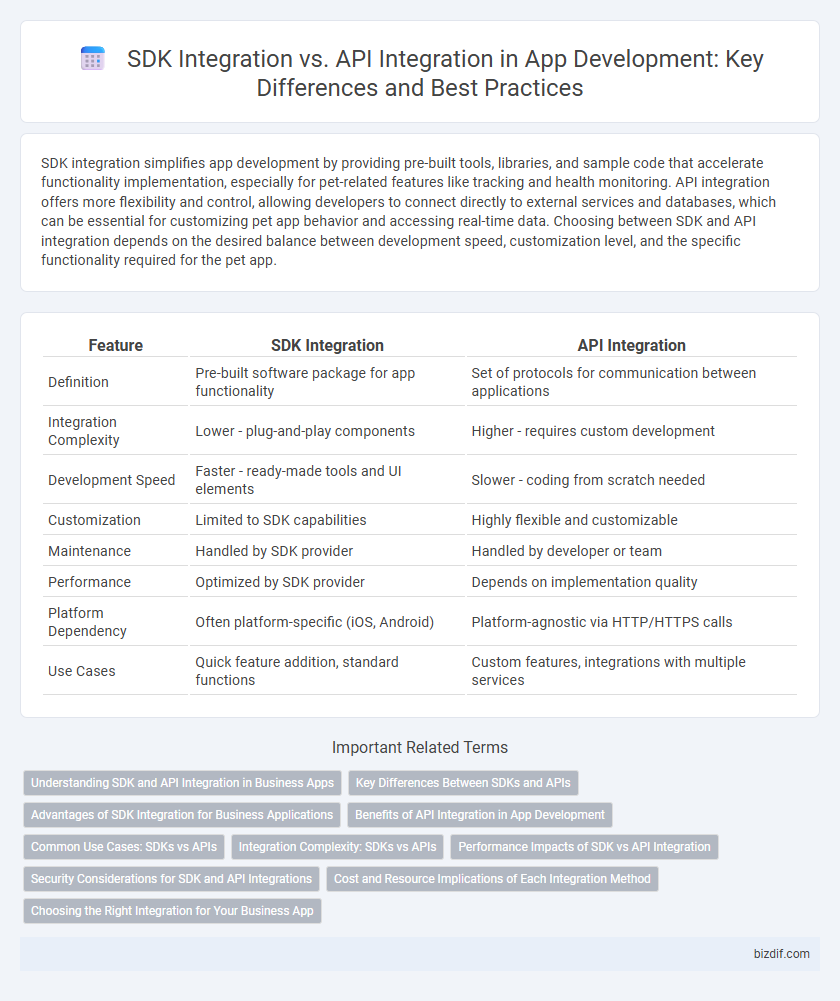SDK integration simplifies app development by providing pre-built tools, libraries, and sample code that accelerate functionality implementation, especially for pet-related features like tracking and health monitoring. API integration offers more flexibility and control, allowing developers to connect directly to external services and databases, which can be essential for customizing pet app behavior and accessing real-time data. Choosing between SDK and API integration depends on the desired balance between development speed, customization level, and the specific functionality required for the pet app.
Table of Comparison
| Feature | SDK Integration | API Integration |
|---|---|---|
| Definition | Pre-built software package for app functionality | Set of protocols for communication between applications |
| Integration Complexity | Lower - plug-and-play components | Higher - requires custom development |
| Development Speed | Faster - ready-made tools and UI elements | Slower - coding from scratch needed |
| Customization | Limited to SDK capabilities | Highly flexible and customizable |
| Maintenance | Handled by SDK provider | Handled by developer or team |
| Performance | Optimized by SDK provider | Depends on implementation quality |
| Platform Dependency | Often platform-specific (iOS, Android) | Platform-agnostic via HTTP/HTTPS calls |
| Use Cases | Quick feature addition, standard functions | Custom features, integrations with multiple services |
Understanding SDK and API Integration in Business Apps
SDK integration provides businesses with comprehensive tools, libraries, and pre-built functionalities that accelerate app development by enabling seamless access to platform-specific features. API integration focuses on establishing communication between different software systems through standardized protocols, allowing data exchange and functionality extension without embedding extensive code. Choosing between SDK and API integration depends on the desired level of control, customization, and the complexity of the business application's interaction with external services.
Key Differences Between SDKs and APIs
SDK integration offers a comprehensive set of development tools, libraries, and documentation enabling faster app creation, whereas API integration provides a specific interface for accessing external services or data without the full toolkit. SDKs bundle multiple APIs and utilities to streamline development, while APIs are individual endpoints requiring manual coding for interactions. Choosing between SDK and API integration depends on project complexity, desired functionality, and development speed in app development.
Advantages of SDK Integration for Business Applications
SDK integration offers comprehensive tools and pre-built functionalities that accelerate app development and ensure seamless compatibility with various platforms. It reduces coding errors and enhances performance by providing native libraries and debugging support, leading to faster deployment and improved user experience. Businesses benefit from SDK integration through streamlined feature implementation, lower development costs, and robust security protocols embedded within the toolkit.
Benefits of API Integration in App Development
API integration in app development enhances scalability by enabling seamless connectivity between diverse software systems and services. It accelerates development cycles through standardized protocols, reducing time to market and maintenance efforts. Access to real-time data and functionalities via APIs drives improved user experiences and fosters innovation within the application ecosystem.
Common Use Cases: SDKs vs APIs
SDK integration is commonly used in app development when developers need pre-built tools, libraries, and frameworks to accelerate feature implementation, such as incorporating payment processing or social media sharing. API integration is preferred for accessing specific external services or data, like retrieving weather information or user authentication through third-party providers. Combining SDKs and APIs often optimizes development efficiency by leveraging comprehensive toolsets while maintaining direct control over data exchanges and service requests.
Integration Complexity: SDKs vs APIs
SDK integration often involves a more comprehensive setup, including additional libraries, tools, and pre-built components, which can simplify development but increase initial complexity. API integration typically requires sending and receiving data through defined endpoints, offering more flexibility but demanding deeper understanding of communication protocols and manual handling of responses. Choosing between SDK and API integration depends on the project's complexity, desired control level, and available development resources.
Performance Impacts of SDK vs API Integration
SDK integration typically offers higher performance due to direct access to native device features and optimized libraries, reducing overhead and latency in app execution. API integration, while more flexible and lightweight, may induce additional network calls and processing delays, potentially impacting real-time responsiveness. Choosing between SDK and API integration depends on balancing performance requirements with development complexity and maintenance scalability.
Security Considerations for SDK and API Integrations
SDK integration often provides built-in security features such as encryption, authentication, and secure data storage, reducing the burden on developers to implement these from scratch. API integration requires careful management of authentication tokens, rate limiting, and secure data transmission protocols like HTTPS to prevent unauthorized access and data breaches. Ensuring regular updates and vulnerability assessments for both SDKs and APIs is critical to maintaining robust security in app development.
Cost and Resource Implications of Each Integration Method
SDK integration often requires higher upfront costs due to licensing fees and more extensive developer resources for implementation, but it offers comprehensive tools that streamline ongoing development and maintenance. API integration tends to have lower initial expenses and allows more flexibility with existing systems, yet it may demand continuous developer effort for updates and troubleshooting. Choosing between SDK and API integration depends on budget constraints, available development resources, and long-term project goals.
Choosing the Right Integration for Your Business App
SDK integration offers comprehensive tools and pre-built components that streamline app development, making it ideal for businesses seeking deep functionality and faster time-to-market. API integration provides greater flexibility and lightweight connectivity, perfect for companies requiring custom features and seamless interaction with existing services. Selecting the right integration depends on your app's complexity, development resources, and the need for scalability or customization.
SDK Integration vs API Integration Infographic

 bizdif.com
bizdif.com